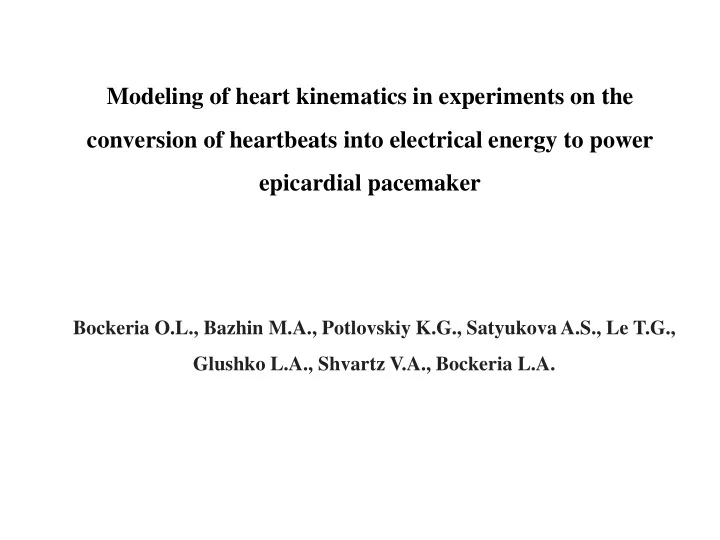

Modeling of heart kinematics in experiments on the conversion of heartbeats into electrical energy to power epicardial pacemaker Bockeria O.L., Bazhin M.A., Potlovskiy K.G., Satyukova A.S., Le T.G., Glushko L.A., Shvartz V.A., Bockeria L.A.
The Aim of the study: - to explore the kinematic activity of the movement of the heart wall to convert the latter into electrical energy to power epicardial pacemaker. The main objectives: - the development of different types of MEMS; - the development of stend imitating kinematic activity of the epicard; - invasive and noninvasive investigation of the epicard for assessment of kinematic activity of the epicard of left ventricle; 2
Methods The Bakoulev Scientific Center for Cardiovascular Surgery is working on the creation of the epicardial pacing system with a converter of the kinematic energy of the heart into electrical energy. We are carrying out the experiments to create a compact system of energy conversion based on the effect of the occurrence of vibrations of the unbalanced inertial mass when making movements with an acceleration that is converted to EMF by magnetoelectric generator. There have been developed and manufactured the Delta robot with six degrees of freedom for laboratory tests, which fully imitated the moving trajectory of the selected part of the epicardium according to the vector analysis of moving particles obtained by Echocardiography in patients with various cardiovascular pathologies. The study was carried out on 6 groups of patients with different cardiovascular pathology: with the lesions of the right coronary artery, the left coronary artery, valve diseases, angina pectoris, myocardial infarction and in patients with lesions of the left main coronary artery. 3
Results According to the data of 90 patients with different cardiovascular pathology the experiments on Delta robot have been successfully done. The first experiments showed the possibility of achieving a specific electrical power on the level of 30 UW, which is sufficient to power the stimulator in the "demand" mode. 4
Conclusions It is established that the transformation of kinematic energy of the heart into electricity, allows reaching required power for a pacemaker in the "demand" mode. Further research is necessary to increase the specific gravity of the converter by optimizing the design and to determine the reliability of the converter. 5
The results of scientific work obtained in 2015 In 2015 year there has been developed the test bench imitating kinematic activity A graph of the acceleration during movement of the platform The platform of the test bench with breadboard model: 1- MEMS model, 2- accelerometer, 3-mobile platform 6
The results of scientific work obtained in 2015 The results of the measurement: № Heart rate Movement Amplitude В per min mm 1 60 8 1,4 2 120 20 3,8 3 120 10 1,3 4 100 20 2,5 5 80 8 1,6 The oscillogram of the signal at the output of the generator with an optional offset 6 80 15 1,9 center of mass. 7
The results of scientific work obtained in 2015 In 2015 the have been obtained and analyzed clinical data of the kinematic activity of the heart in patients with ischemic heart disease and valvular pathology. An example of obtaining clinical data in patient with ischemic heart disease. The definition of circular velocity, the displacement over the cardiac cycle at basal level 8
Recommend
More recommend